Sore Feet In Morning? [Causes, Symptoms & Best HOME Treatment]
Sore Feet In Morning? This is one of the most painful and #1 most common foot problems. 15% of the entire world will suffer from this condition.
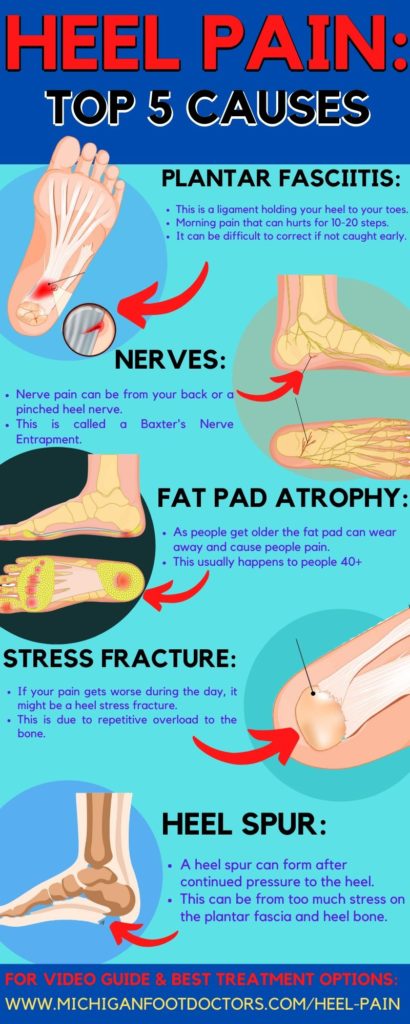
Table of Contents
Heel Pain Causes: Picture & Photo Gallery
Look:
- One of the top causes of heel pain is plantar fasciitis. This is damage to a ligament that holds your heel to your toes.
- Another root cause of heel pain has flat feet.
- There are also photos of heel spurs that can occur to the bottom of your heel (plantar fascia insertion) and the back of your heel (Achilles tendon insertion).
- Baxter’s nerve entrapment can also happen at the bottom of the heel.
- An underlying cause is an overpronated flatfoot or an over a supinated high arched foot.
- A plantar fibroma is a thick nodule that can occur within your plantar fascia ligament and contribute to plantar fasciitis.
- This can lead to the formation of a heel stress fracture( AKA calcaneus stress fracture.)
Please click on the gallery for a guided tour through heel pain conditions!
Sore Feet In Morning Overview:
- Sore feet in the morning are almost always due to plantar fasciitis.
- This is the number one most common cause of heel pain, especially if you’re feeling it in the morning and it gets better after about 15 minutes of walking.
- This is due to tearing of your planar fascia ligament as it inserts into the calcaneus bone.
- If left untreated, eventually heel spur does development and further biomechanical problems.
- We go over the planar fasciitis disease, and show great treatment recommendations.
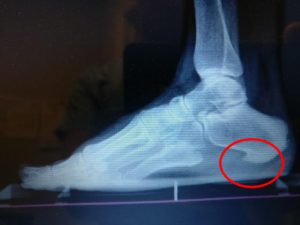
What Are Sore Feet In Morning?
Sore feet in the morning are due to a condition called inflammation:
- Inflammation is an attempt by the body to heal itself.
- Inflammation is the necessary first step of tissue remodeling.
- If you damage & overuse your muscles and ligaments, the body attempts to repair them.
- Morning soreness is the body not being able to finish healing in time.
- This pain usually builds up over years or decades!
- Jump Straight To The Treatment Guide!
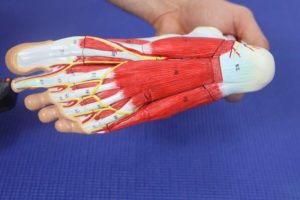
Symptoms of Feet Hurting In The Morning:
- Foot pain after sitting.
- Foot pain after sleeping.
- They hurt more after a long day of standing or walking.
- Pain usually gets better after walking for 15-20 minutes or so.
- Pain gets better with Aspirin or Ibuprofen.
- Massaging the arches or heel makes it feel much better.
- Elevating or icing the feet make them feel better.
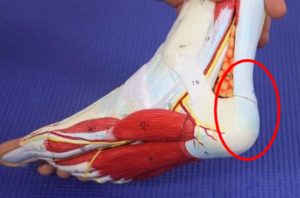
Causes Of Sore Feet In Morning:
Your feet hurt in morning because they are overused during the day:
- As you walk on your feet, the muscles & ligaments become damaged and stretched.
- Stretching your ligaments is like stretching an old elastic over and over.
- Eventually it will start to crack and then eventually brake.
- This happens to your foot tissue known as the plantar fascia.
- This tissue develops small cracks & stretch marks that need healing.
- This morning pain is your body telling you to walk less & let it heal!
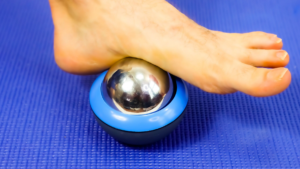
Who Is At Risk For Feet Hurting In The Morning:
Anyone who puts more stress & overuse on their feet:
- Overweight people.
- Older people.
- Flat foot people.
- Less cushioned or supportive shoes.
- No arch support.
- Walking more barefoot.
- Running more.
- Standing on your feet all day at work.
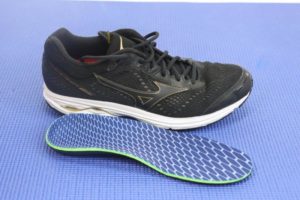
My Feet Hurt In The Morning Treatment:
Treatment usually consists of 4 stages:
1)Confirm pain is due to soreness in the morning:
- Make sure this is what you have before starting treatment.
- It is very annoying to lose time and money to treat the wrong thing.
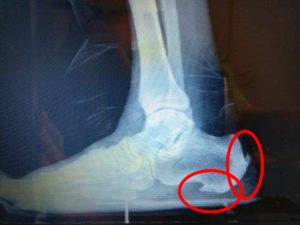
2) Stop feet from hurting in the morning:
- Getting rid of the pain is the #1 goal.
- This can be done very effectively according to research.
3) Keep the feet from hurting in the morning:
- Abnormal biomechanics or unusual stress on your foot is usually to blame.
- It is essential that you control your foot biomechanics:
- This is done through shoe selection, arch control, stretching & strengthening exercises.
4) Extensive therapy for morning foot soreness:
- This is usually only needed in 5% of people.
- Find out if surgery, steroid injections or ultrasound are necessary.
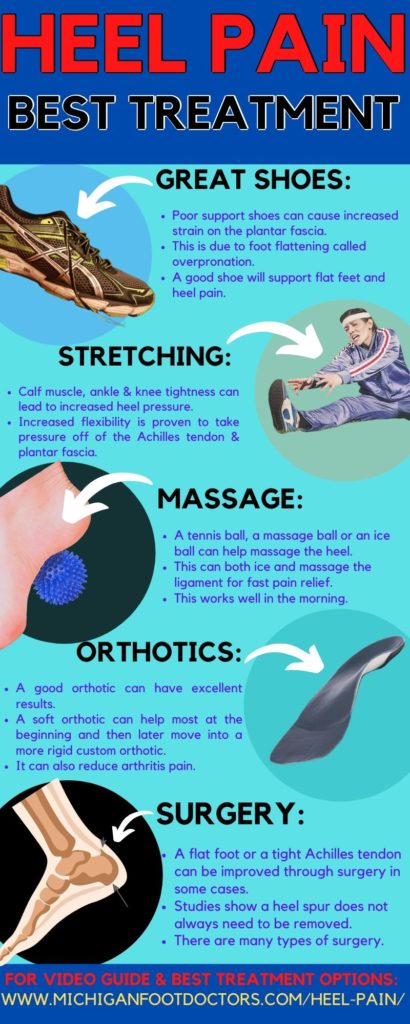
Best Heel Pain Products:
- There are usually two phases to treating plantar fasciitis pain.
- The two phases of treatment include controlling the acute inflammation, and correcting the biomechanics which led to the problem in the first place.
- If the tendons and ligaments are inflamed, they are almost frozen in place and cannot function properly.
- Once the inflammation is decreased, we need to correct the bio-mechanical causes to ensure that they can never become over worked and inflamed again!
- This doesn’t matter whether it’s plantar fasciitis, plantar fibroma, sore bottom of foot, or even Achilles tendon pain. Treatment is all roughly very similar.
Plantar Fasciitis or Achilles Tendonitis Inflammation:
Massage & Ice Products:
- Ice is the an excellent option that can be safe for almost everyone.
- There is some debate whether icing is worth doing, but for chronic pain this can help limit the need for medications and keep your options open.
- This works great for your arch, less for the ball of the foot.
- The more muscle and ligament tissue there is, the better ice will work there.






Menthol Based Gels:
- Biofreeze is one of our favorites.
- These gels have been studied to work 2x as long as ice.
- This works great for the ball of the foot.
- This can be very effective for bottom of the heel and Achilles tendon sore regions.








Massage Sticks:
- These can work great for loosening your muscles.
- This allows less tightness and pressure on the ball of your foot.
- This is very effective for the arch, the gastrocnemius or calf muscle and for the hamstring and thigh muscles.
- This also works very well for the gluteus muscles if you are having butt cheek or hip pain.






Remove the Plantar Fascia or Achilles Tendon Stress:
- The key is to prevent future pain.
- This means keeping you active while keeping stress off of your plantar fascia tendon. This will prevent future re-injury and development of plantar fasciitis.
- If you can get rid of the pain and swelling, this will let you start walking normally.
- If you can walk normally, the vast majority of your pain should gradually start to go away.
- The best way to ensure that your plantar fascia, foot and ankle ligaments are not overworked is to support them.
- The best way to support them is to use great orthotics and great shoes.
- Some people may also need to rely on supportive ankle braces and other supportive modalities.
The Best Heel Pain & Plantar Fasciitis Shoes:
- Getting a great supportive pair of shoes will make sure that there is pressure removed from the heel and plantar fascia region.
- This is especially important if you have plantar fasciitis, heel spur pain or Achilles tendonitis.
- Consider shoes combined with a good supportive orthotic for best pain relief!
- The following link will show you what our favorites are.
Best Heel Pain & Plantar Fasciitis Orthotics:
- These are our recommended orthotics for plantar fasciitis.
- Custom orthotics can work very well, but they should not be a first line of treatment.
- There are different types for different shoes.
- Women’s shoes usually need a less bulky orthotic, but allow for less correction.
- A full length orthotic requires a running shoe, boot or comfortable walking/dress shoe.
- We recommend doing everything you can to get a good supportive shoe that can fit a full length orthotic.
- This is the best way to maximize your orthotics for great results.
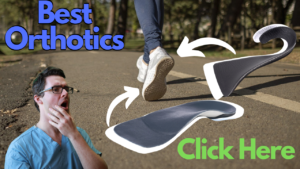
Best Full Length Orthotics:
- These will only work in wider shoes or a good supportive running shoe.
- This will not work in sandals, flats or most women’s dress shoes.








Best Dress Shoe Orthotics:
- These are a great choice for dress orthotics.






Best 3/4 Length Orthotics:
- These are great options for women’s dress shoes and thinner shoes.
- These are not the most supportive pair of orthotics.


Get A Great Dynamic Stretch:
- It is possible to stretch on your own, but these products can also really help!
- This will take pressure off of the ball of your foot.
- We personally prefer this method of stretching.








Get A Great Static Stretch:
- These devices are great for stretching while you are resting.
- This will also help take pressure off of the ball of your foot.
- This works great for plantar fasciitis.
- It can be used while watching TV or at night time.






Best Heel Compression Brace:
- A good compression brace can stabilize your foot from turning outward.
- This prevents your foot from pronated.
- Pronated foot will turn your foot outward in your foot will rub on the outside of the shoe.
- For many of her patients this has solved their pain and is very comfortable to wear inside your shoe.
- This solves both pain and outward pronation for a relatively low cost.




Best Heel Stability Brace:
- Stability brace goes little bit further than the compression brace to stop your foot from turning out.
- This takes pressure off of your heel and plantar fascia.
- At the same time this is a little bit bulkier and does not affect every shoe.
- We find people are little bit happier trying the compression brace before the stability brace.






Heel Injury:
- If you think you might have a broken heel, a calcaneal stress fracture or something of similar severity, these products might help!
- Always remember to see a foot and ankle specialist like a podiatrist if you are having plantar fasciitis or more severe pain!
Plantar Fascia Tear, Broken Heel Bone, Achilles Tendon Tear:
- If you have a traumatic injury such as a torn plantar fascia ligament, calcaneus stress fracture, heel fracture or insertional Achilles tendon injury: consider protecting your foot!
- The best way to do this is of course to see your podiatrist and get evaluated with an x-ray, ultrasound and potentially even an MRI or CT scan.
- If you are unable to do so it may benefit you to be in a cast, fractured boot, or even keep the weight off of it with a rolling knee scooter or other protective devices.
- We as podiatrists frequently take patients off work for very long period of time when they suffer a traumatic injury, unfortunately there is no other way around us in labor jobs.
- If you have a sit down job there are ways to get people back to work quicker, but this can be very difficult otherwise.
Heel Injury Boot Treatment:
- There are pros and cons to using a boot to treat your heel injury. If you are immobilized too long the cons are that you will gradually become stiff and overworked to your other leg. The Pros are that you injured heel will hopefully have a chance to gradually heal!
- Our favorite fracture boots and their supplies:








Offloading and Scooter treatment:
- These are favorite knee scooters and walking devices:








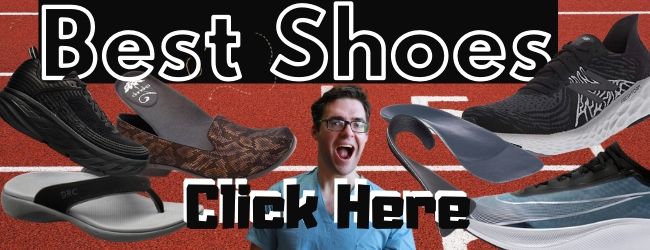
 Compare Prices:
Compare Prices: